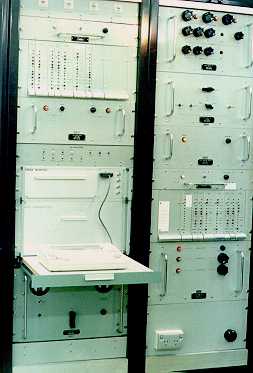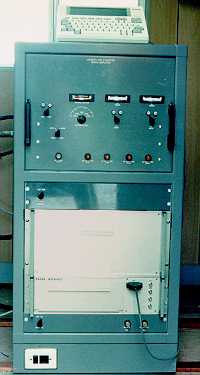The Rapic Transmitter was developed in the Bureau in 1983 & 84 as part of a project to provide radar displays at the Weather Service Offices (located at airports) around the nation. After extensive testing at Laverton Vic. the first system outside Melbourne was installed in 1985 on the Adelaide Airport WF44. Over the ensuring fifteen years, about 60 systems were installed on both Plessey and EEC radars not only throughout Australia but also in P.N.G., Fiji, New Zealand, Malaysia and Indonesia. The Rapic Transmitter proved to be remarkably reliable and failures of the parent radar and the linking communication systems were far more often the cause of perceived failure than ever the actual transmitter itself.
 |
 |
|
Rapic Tx in a WF44 Radar
|
Rapic Tx in a WF100 Radar
|
GENERAL DESCRIPTION
The Rapic Transmitter is a unit which inputs radar information and outputs it
in a serial format which is suitable for reception and display by systems such
as the Rapic Receiver, PC Rapic
and 3dRapic.
The Rapic Tx. is normally programmed to periodically control the radar, for
a series of rotations. The data is then captured, processed and then sent for
display. Also remote control of the radar is possible from a PC Rapic to obtain
custom vertical sweeps, known as RHI (Range Height Indicator) or azimuth rotations,
known as PPI (Plan Position Indicator)
By inputting data over multiple passes at different elevations, the unit can
be set up to input CAPPI (Constant Altitude PPI) type radar images, and to reduce
the unwanted affects from Permanent Echoes.
Normal or Base Scan operation
The Rapic Transmitter system periodically seizes control of the radar and collects
"Base Scan" data by compositing data from a few PPI scans (between 1 and 5)
into a single scan for routine radar surveillance and also merged radar network
usage.
Typically, this radar data is captured at an azimuthal resolution of one degree,
a range resolution of two kilometres, and seven reflectivity threshold levels.
Volumetric operation
In this mode, the Rapic Transmitter system periodically seizes control of the
radar to capture a set of Volumetric scans and does so only if a 3D-Rapic display
system is connected to the Volumetric port of the Rapic Transmitter, and the
Rapic Transmitter has been appropriately configured.
A Volumetric set of scans is a series of constant elevation scans (PPIs) captured
at progressively increasing elevations. The Rapic Transmitter is usually configured
to capture between 12 and 20 scans for each set . Volumetric Data is usually
collected at an azimuthal resolution of 1 degree, a range resolution of 1 kilometre,
and sixteen reflectivity threshold levels.
Maintenance Terminal
|
A NEC PC-8201 was provided as the first maintenance terminal with the Rapic Ttransmitter. With the terminal connected, the technician calibrated the levels etc., set operating options, tested the output/communications and also could monitor the normal running of the unit.
|
 |